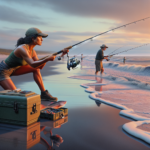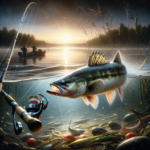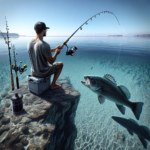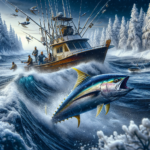Casting for Grouper in Texas’ Gulf Coast
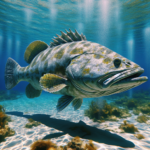
Introduction
Did you know that the Gulf Coast of Texas is home to some of the best grouper fishing in the United States? Whether you’re a seasoned angler or a novice looking to try your hand at catching this prized species, the Texas Gulf Coast offers a unique and rewarding fishing experience. This article will cover everything you need to know about casting for grouper in this region, from the best fishing techniques and gear to the top fishing spots and seasonal considerations.
Understanding the intricacies of grouper fishing in Texas is essential for anyone looking to make the most of their fishing trip. Not only will this guide help you find the best locations and times to fish, but it will also provide valuable tips and best practices to ensure a successful and enjoyable experience.
Background/Context
Historical or Cultural Significance
Grouper fishing has long been a part of the cultural fabric of the Gulf Coast. Historically, these fish were a staple for local communities, providing both food and economic opportunities. Today, grouper fishing remains a popular activity, attracting anglers from all over the country who are eager to experience the thrill of catching these powerful fish.
Geographical Overview
The Texas Gulf Coast stretches over 350 miles, featuring a diverse range of ecosystems, from sandy beaches and estuaries to deep offshore waters. The region’s warm climate and nutrient-rich waters create an ideal habitat for grouper, making it a prime destination for anglers. The Gulf’s unique topography, including underwater structures like reefs and shipwrecks, provides excellent hiding spots for grouper, further enhancing the fishing experience.
Key Points/Details
Fishing Techniques
Technique Overview
When it comes to grouper fishing, several techniques can be employed, including bottom fishing, trolling, and jigging. Bottom fishing is the most common method, involving dropping baited hooks to the ocean floor where grouper are known to dwell. Trolling involves dragging lures or baited hooks behind a moving boat, while jigging uses weighted lures that are jerked up and down to attract fish.
When and Where to Use
Bottom fishing is particularly effective around underwater structures like reefs and shipwrecks, where grouper tend to congregate. Trolling can be useful in deeper waters where grouper are more spread out, while jigging is often employed in areas with strong currents or around vertical structures.
Recommended Gear
- Rods: Heavy-duty rods capable of handling large fish.
- Reels: High-capacity reels with strong drag systems.
- Lines: Braided lines with a high breaking strength.
- Bait/Lures: Live bait such as pinfish or squid, and artificial lures like jigs and plugs.
Species Information
Species Overview
Grouper are a diverse group of fish known for their stout bodies and large mouths. Common species found in the Texas Gulf Coast include the Gag Grouper, Red Grouper, and Black Grouper. These fish are typically found in deeper waters, often around structures like reefs and wrecks. Grouper are known for their strong fighting abilities, making them a challenging and rewarding catch for anglers.
Best Practices
To successfully catch grouper, it’s important to use strong, durable gear and to fish around structures where these fish are likely to be hiding. Live bait is often more effective than artificial lures, and it’s crucial to be patient and persistent, as grouper can be elusive. The best times to fish for grouper are typically early morning or late afternoon, when they are most active.
Location Information
Top Fishing Spots
- Port Aransas: Known for its rich fishing grounds and easy access to offshore waters.
- Galveston: Offers a variety of fishing opportunities, from piers and jetties to deep-sea charters.
- South Padre Island: A popular destination with abundant marine life and excellent fishing conditions.
Regulations and Licenses
Before heading out, it’s important to familiarize yourself with local fishing regulations. In Texas, anglers need a valid fishing license, and there are specific regulations regarding grouper, including size and bag limits. It’s essential to check the latest regulations from the Texas Parks and Wildlife Department to ensure compliance.
Seasonal Considerations
Seasonal Variations
Fishing conditions on the Texas Gulf Coast can vary significantly throughout the year. During the warmer months, grouper are more active and can be found in shallower waters. In contrast, colder months may require fishing in deeper waters where the temperature is more stable.
Best Times to Fish
The optimal seasons for grouper fishing are typically late spring through early fall. Early morning and late afternoon are the best times of day to fish, as grouper are more likely to be feeding during these periods.
Events and Tournaments
Event Overview
The Texas Gulf Coast hosts several fishing tournaments throughout the year, many of which include categories for grouper. Events like the Texas International Fishing Tournament and the Port Aransas Deep Sea Roundup attract anglers from all over, offering opportunities to compete and win prizes.
Preparation Tips
To prepare for a fishing tournament, it’s important to practice your techniques and familiarize yourself with the tournament rules. Ensure your gear is in top condition, and consider scouting the fishing area ahead of time to identify potential hotspots.
Tips and Best Practices
General Tips
- Always use fresh bait to increase your chances of attracting grouper.
- Be patient and persistent, as grouper can be elusive and require time to catch.
- Pay attention to the tides and currents, as these can significantly impact fishing conditions.
Avoid Common Mistakes
- Using gear that is too light: Grouper are strong fish and require heavy-duty equipment.
- Ignoring local regulations: Always check the latest fishing regulations to avoid fines and penalties.
- Fishing in the wrong spots: Focus on areas with structures like reefs and wrecks where grouper are likely to be hiding.
Advanced Techniques
- Using a fish finder to locate underwater structures and schools of fish.
- Employing chumming techniques to attract grouper to your fishing area.
- Experimenting with different types of lures and bait to see what works best in different conditions.
Gear and Equipment Recommendations
Essential Gear
- Heavy-duty fishing rod and reel
- Braided fishing line with high breaking strength
- Live bait such as pinfish or squid
- Artificial lures like jigs and plugs
Optional Gear/Upgrades
- Fish finder to locate underwater structures
- Chum bucket to attract fish to your area
- High-quality tackle box to organize your gear
Where to Buy or Rent
Local bait and tackle shops in coastal towns like Port Aransas, Galveston, and South Padre Island offer a wide range of fishing gear and equipment. Additionally, online retailers like Bass Pro Shops and Cabela’s provide extensive selections and convenient shipping options.
Safety and Conservation
Safety Tips
- Always check the weather forecast before heading out to sea.
- Wear a life jacket and ensure all safety equipment is in good working order.
- Be aware of local wildlife and avoid disturbing their habitats.
Conservation Practices
- Practice catch and release to help maintain healthy fish populations.
- Follow local fishing regulations, including size and bag limits.
- Dispose of fishing line and other waste properly to protect the environment.
Planning Your Trip
Accommodations
There are numerous accommodation options along the Texas Gulf Coast, ranging from budget-friendly motels to luxury resorts. Popular choices include beachfront hotels in Galveston, vacation rentals in Port Aransas, and campgrounds near South Padre Island.
Travel Tips
The Texas Gulf Coast is easily accessible by car, with major highways connecting coastal towns. For those flying in, airports in Houston, Corpus Christi, and Brownsville offer convenient access to the region. Renting a car is recommended for exploring different fishing spots and local attractions.
Additional Activities
In addition to fishing, the Texas Gulf Coast offers a variety of activities for visitors. Enjoy beachcombing, birdwatching, kayaking, and exploring local attractions like the Texas State Aquarium in Corpus Christi or the historic Strand District in Galveston.
Frequently Asked Questions (FAQs)
What is the best time of year to fish for grouper on the Texas Gulf Coast?
The best time of year for grouper fishing is typically late spring through early fall, with early morning and late afternoon being the optimal times of day.
Do I need a fishing license to fish for grouper in Texas?
Yes, a valid Texas fishing license is required for all anglers. Be sure to check the latest regulations from the Texas Parks and Wildlife Department.
What type of bait is best for catching grouper?
Live bait such as pinfish or squid is often more effective than artificial lures when targeting grouper.
Are there any local fishing tournaments that include grouper categories?
Yes, several fishing tournaments along the Texas Gulf Coast include categories for grouper, such as the Texas International Fishing Tournament and the Port Aransas Deep Sea Roundup.
Conclusion
Casting for grouper on the Texas Gulf Coast offers a thrilling and rewarding experience for anglers of all skill levels. By understanding the best fishing techniques, gear, and locations, you can increase your chances of success and make the most of your fishing trip. Remember to follow local regulations, practice conservation, and prioritize safety to ensure a positive and sustainable fishing experience. Whether you’re a seasoned pro or a beginner, the Texas Gulf Coast is a prime destination for grouper fishing that promises excitement and adventure.

